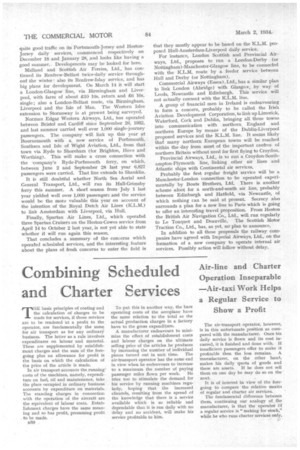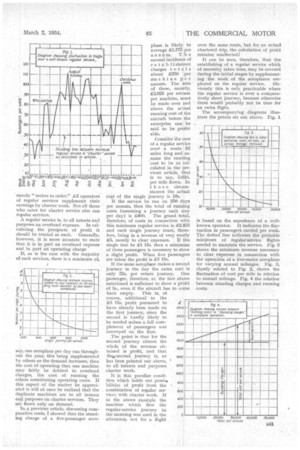Combinint Scheduled and Charter Services
Page 44

Page 45

If you've noticed an error in this article please click here to report it so we can fix it.
Air-line and Charter Operation Inseparable —Air-taxi Work Helps a Regular Service to Show a Profit
THE basic principles of costing' and the calculation of charges to be made for services, if those services are to be rendered at a profit to the operator, are fundamentally the same for air transport as for any ordinary business. The latter as a rule involves expenditures on labour and material. These are supplemented by establishment charges and the sum of the foregoing plus an allowance for profit is the basis on which the calculation of the price of the article is made.
In air transport accounts the running costs of the machines, namely, expenditure on fuel, oil and maintenance, take tlie place occupied in ordinary business accounts by expenditure on materials. The standing charges in connection with the operation of the aircraft are the equivalent of labour costs. Establishment charges have the same meaning and so has profit, presuming profit to be made.
n30
To put this in another way, the bare operating costs of the aeroplane have the same relation to the total as the actual production charges in a factory have to the gross expenditure.
A manufacturer endeavours to minimize the effect of establishment costs and labour charges on the ultimate selling price of the articles he produces by increasing the number of individual pieces turned out in unit time. The air-transport operator has the same end in view when he endeavours to increase to a maximum the number of paying passenger miles flown per week. He tries too to stimulate the demand for his service by running machines regularly, hoping that the increased clientele, resulting from the spread of the knowledge that there is a service available which is so reliable and dependable that it is run daily with no delay and no accident, will make his service profitable to him.
The air-transport operator, however, is in this unfortunate position as compared with the manufacturer. Once his daily service is flown and its cost incurred, it is finished and done with. If insufficient passengers offer to make it profitable then the loss remains. A manufacturer, on the other hand, makes his daily quota of goods and these are assets. If he does not sell them on one day he may do so on the next.
It is of interest in view of the foregoing to compare the relative merits of regular and charter air services.
The fundamental difference between them, continuing our analogy of the manufacturer, is that the operator bf a regular service is "making for stock," while he who runs charter services only,
'merely "makes to order." All operators of regular services supplement their earnings by charter work. Not all those who cater for charter service also run • regular services.
A regular service is, to all intents and purposes an overhead expense. In calculating the prospects of profit it should he treated as such. Generally, however, it is more accurate to state that it is in part an overhead expense and in part an operating charge If, as is the case with the majority of such services, there is a minimum of say, one aeroplane per day run throughout the year, this being supplemented by others as the demand increases, then the cost of operating that one machine may fairly be debited to overhead charges, the cost of running the others constituting operating costs. If this aspect of the matter be appreciated it will at once be realized that the duplicate machines are to all intents and purposes on charter services. They are flown only on demand.
In, a previous article, discussing comparative costs, I showed that the standing charge of a five-passenger aero
pla.ne is likely to average £1,775 per annum. The annual incidence of es t a bli shment charges totals about £250 per machine per annum. The sum of these, namely, £2,025 per annum per machine, must be made over and above the actual running cost of the aircraft before the enterprise can be said to be profit= able.
Consider the case of a regular service over' a route 52 miles long and as
the running cost to be as calculated in the previous article, that is to say, 3.62d. per mile flown. In t hose circum stances the actual cost of the single journey is 16s.
If the service be run on 250 days per annum, then the total of running costs (assuming a journey each way per day) is £400. The grand total, therefore, of costs in connection with this minimum regular service is £2,425 and each single journey must, therefore, bring in a revenue of very nearly £5, merely to clear expenses. If the single fare be £1 15s. then a minimum of three passengers is necessary to show a slight profit. When five passengers are taken the profit is £3 15s.
If the same aeroplane makes a second journey in the day the extra cost is only 32s. per return journey. One passenger, therefore, at the fare above mentioned is sufficient to show a profit of 3s., even if the aircraft has to come back empty. This is, of course, additional to the £3 15s. profit presumed to / have already been made on the first journey, since the second is hardly likely to be needed unless a full complement of passengers was
conveyed on the first. 2000
,The point is that for the second journey almost the whole of the revenue obtained is profit, and that
2000
2400
2200 1600 /600
—
the. second journey is, as r400 has been pointed out above, to all intents and purposes charter work.
It is this peculiar condition which holds out possiv bilities of profit from the combination of regular services with chatter work. If in the above example the machine which flew the regular-service journey inthe morning was used in the afternoon, not for a flight
over the same route, but for an actual chartered trip, the calculation of profit remains unaffected: It can be seen, therefore, that the establishing of a regular service which of necessity takes time, may be covered during the initial stages by supplementing . the work of the aeroplanes em
ployed on the regular service. Obviously this is only practicable where the regular service is over a comparatively short journey, because otherwise there would probably not be time for an extra flight.
The accompanying diagrams illustrate the points set out above. rig. 1 is based on the experience of a wellknown operator. It indicates the fluctuation in passengers carried per week. The dotted line indicates the probable minkrnum of regular-service flights needed to maintain the service. Fig. 2 shows the minimum revenue necessary to clear expenses in connection with the operation of a five-seater aeroplane for varying annual mileages. Fig. .1, closely related to Fig. 2, shows the fluctuation of cost per mile in relation to annual mileage. Fig. 4 the relation between standing charges and running costs.




























































































